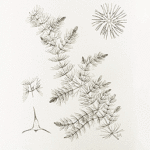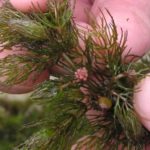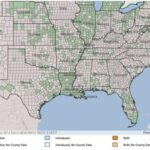Ceratophyllum demersum
Illustration courtesy of University of Florida/IFAS Center for Aquatic and Invasive Plants. Used with permission.
What is Coontail?
Physical Characteristics
Leaves:
- Entirely under water
- Up to 12 leaves in a whorl
- Straight and flat
- Variable length, usually about 0.59 inches long
Stems:
- Up to 11.4 feet long
- Branching
- Form large masses
- Brittle
- Somewhat cord-like and flexible
Fruit/Seeds:
- Elliptical-shaped
- Tightly packed
- Smooth
- About 0.16-0.19 inches long
Where Does it Grow?
USDA, NRCS. 2018. The PLANTS Database (http://plants.usda.gov). National Plant Data Team, Greensboro, NC 27401-4901 USA.
Coontail can be found in the quiet waters of lakes, ponds, and slow streams.
Pros and Cons of Coontail
The fruits of coontail are consumed by ducks and it is considered a good wildlife food. Submerged portions of all aquatic plants provide habitats for many micro and macro invertebrates. These invertebrates in turn are used as food by fish and other wildlife species (e.g. amphibians, reptiles, ducks, etc.). After aquatic plants die, their decomposition by bacteria and fungi provides food (called “detritus”) for many aquatic invertebrates.








